Year 1488 (MCDLXXXVIII) was a leap year starting on Tuesday of the Julian calendar.

The Panthéon is a monument in the 5th arrondissement of Paris, France. It stands in the Latin Quarter, atop the Montagne Sainte-Geneviève, in the centre of the Place du Panthéon, which was named after it. The edifice was built between 1758 and 1790, from designs by Jacques-Germain Soufflot, at the behest of King Louis XV of France; the king intended it as a church dedicated to Saint Genevieve, Paris's patron saint, whose relics were to be housed in the church. Neither Soufflot nor Louis XV lived to see the church completed.

The Basilica of Saint-Denis is a large former medieval abbey church and present cathedral in the commune of Saint-Denis, a northern suburb of Paris. The building is of singular importance historically and architecturally as its choir, completed in 1144, is widely considered the first structure to employ all of the elements of Gothic architecture.

René of Anjou was Duke of Anjou and Count of Provence from 1434 to 1480, who also reigned as King of Naples as René I from 1435 to 1442. Having spent his last years in Aix-en-Provence, he is known in France as the Good King René.
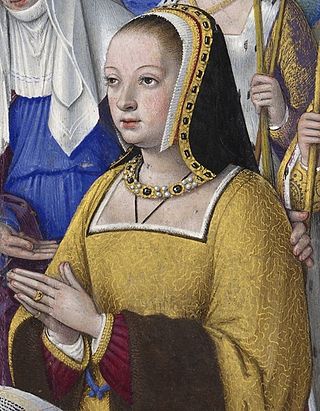
Anne of Brittany was reigning Duchess of Brittany from 1488 until her death, and Queen of France from 1491 to 1498 and from 1499 to her death. She was the only woman to have been queen consort of France twice. During the Italian Wars, Anne also became Queen of Naples, from 1501 to 1504, and Duchess of Milan, in 1499–1500 and from 1500 to 1512.
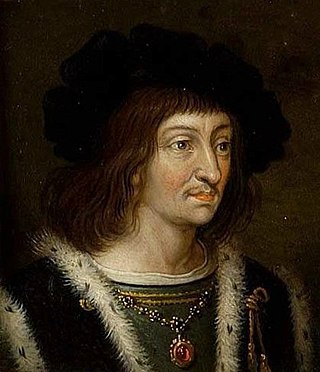
John II of Anjou was Duke of Lorraine from 1453 to his death. He was the son of René of Anjou and Isabella, Duchess of Lorraine. He was married to Marie de Bourbon, daughter of Charles I, Duke of Bourbon.

Duke of Bourbon is a title in the peerage of France. It was created in the first half of the 14th century for the eldest son of Robert of France, Count of Clermont, and Beatrice of Burgundy, heiress of the lordship of Bourbon. In 1416, with the death of John of Valois, the Dukes of Bourbon were simultaneously Dukes of Auvergne.
Charles de Bourbon was the oldest son of John I, Duke of Bourbon and Marie, Duchess of Auvergne.

Charles II, Duke of Bourbon, was Archbishop of Lyon from an early age and a French diplomat under the rule of Louis XI of France. He had a 2-week tenure as Duke of Bourbon in 1488, being ousted afterward by his younger brother and successor, Peter II, Duke of Bourbon.

The Monastery of Batalha is a Dominican convent in the municipality of Batalha, in the district of Leiria, in the Centro Region of Portugal. Originally, and officially, known as the Monastery of Saint Mary of the Victory, it was erected in commemoration of the 1385 Battle of Aljubarrota and would serve as the burial church of the 15th-century Aviz dynasty of Portuguese royalty. It is one of the best and original examples of Late Flamboyant Gothic architecture in Portugal, intermingled with the Manueline style.
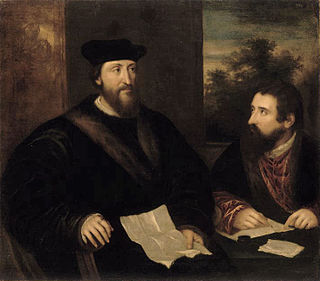
Georges d'Armagnac was a French humanist, patron of arts, Cardinal and diplomat deeply embroiled in the Italian Wars and in the French Wars of Religion.
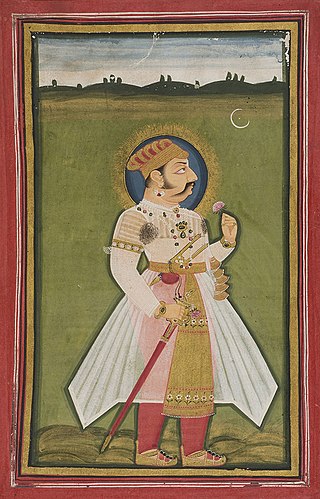
Kumbhakarna Singh, popularly known as Maharana Kumbha, was the Maharana of the Kingdom of Mewar in India. He belonged to the Sisodia clan of Rajputs. Rana Kumbha is known for his illustrious military career against various sultanates and patronization of art and music and architecture.

John Stourton, 1st Baron Stourton of Stourton, Wiltshire, was an English soldier and politician, elevated to the peerage in 1448.

Enguerrand Quarton was a French painter and manuscript illuminator whose few surviving works are among the first masterpieces of a distinctively French style, very different from either Italian or Early Netherlandish painting. Six paintings by him are documented, of which only two survive, and in addition the Louvre now follows most art historians in attributing to him the famous Avignon Pietà. His two documented works are the remarkable Coronation of the Virgin and The Virgin of Mercy. Two smaller altarpieces are also attributed to him.

Anne of Cyprus was a Duchess of Savoy by marriage to Louis, Duke of Savoy. She was the daughter of King Janus of Cyprus and Charlotte of Bourbon; and a member of the Poitiers-Lusignan crusader dynasty. She was highly influential in the Duchy of Savoy and acted as the political advisor and the de facto ruler on the wish of her spouse.

Isabella of Urgell, Duchess of Coimbra was a Catalan noblewoman of the Urgell branch of the House of Barcelona. She was the wife of Infante Peter, Duke of Coimbra.
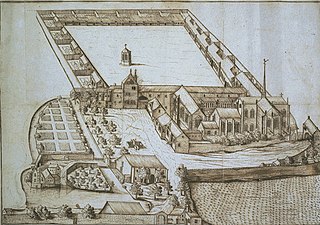
The Chartreuse de Champmol, formally the Chartreuse de la Sainte-Trinité de Champmol, was a Carthusian monastery on the outskirts of Dijon, which is now in France, but in the 15th century was the capital of the Duchy of Burgundy. The monastery was founded in 1383 by Duke Philip the Bold to provide a dynastic burial place for the Valois Dukes of Burgundy, and operated until it was dissolved in 1791, during the French Revolution.

Antoine Le Moiturier (1425–1495) was a French sculptor. He was born in Avignon into a family of sculptors. His uncle was the itinerant French master Jacques Morel.

Giorgio Schiavone, or Juraj Ćulinović, was a Croatian Renaissance painter, active in North Italy and Dalmatia. He is considered the most important Croatian painter of the 15th century.
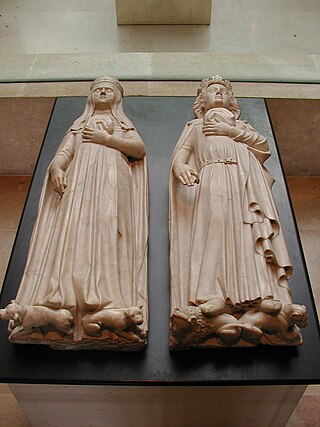
Jean de Liège, (c.1330-1381) was a 14th-century sculptor of Flemish origin, mainly active in France, who specialized in funerary sculptures.


















